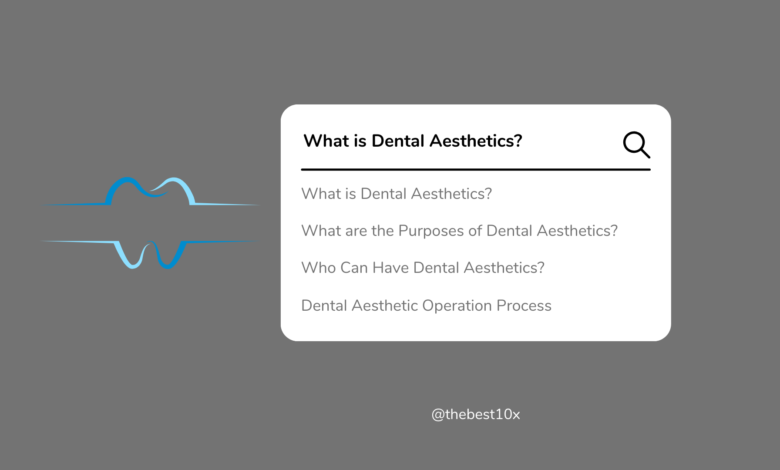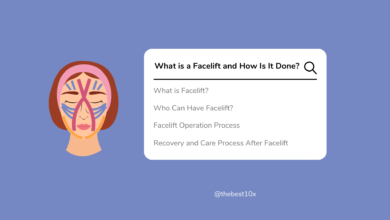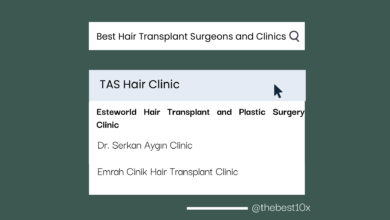
What is Dental Aesthetics? How is it done?
Dental aesthetics is an aesthetic dental procedure that aims to correct the appearance of the teeth in order to make your smile more attractive and healthy. This method, which is applied to correct aesthetic problems such as color, size, shape or irregularity in teeth, can help patients increase their self-confidence and achieve a healthier smile. Dental aesthetics can include different treatment options such as teeth whitening, porcelain veneers, bonding, braces and dental implants. In this article, we will explore in more detail the different aspects of dental aesthetics and their application methods.
What Is Dental Aesthetics?
Dental aesthetics is a medical discipline that includes a range of dental procedures performed to improve the appearance and aesthetic appeal of individuals’ teeth. Dental aesthetics aims to achieve a more attractive smile by improving the color, size, shape, arrangement and position of the teeth. These procedures are used to solve various aesthetic problems, such as removing stains from teeth, straightening crooked teeth, closing gaps or repairing broken teeth. Dental aesthetics can include different treatment options such as porcelain veneers, bonding, teeth whitening, braces and dental implants. These procedures can help patients achieve a healthier and aesthetically satisfying smile while boosting their self-confidence.
What Are The Purposes Of Dental Aesthetics?
A beautiful face and aesthetic appearance is an important element that increases the self-confidence of individuals. Therefore, addressing aesthetic concerns plays a major role in increasing personal satisfaction and self-confidence. However, beauty and aesthetics are not limited to the external appearance of the face. A smile is one of the key elements that determine a person’s personal charm and self-confidence. At this point, dental aesthetics comes into play and helps people achieve a healthier and more aesthetic smile.
Aesthetic Goals of Dental Aesthetics:
Beautifying Your Smile: Dental aesthetics aims to achieve a more attractive smile by improving the appearance of the teeth. It solves aesthetic problems such as removing stains, whitening yellowed teeth or closing gaps between teeth.
Achieving Dental Symmetry and Harmony: Symmetry and harmony of the teeth play a critical role in the aesthetic appeal of a person’s smile. By providing this symmetry, dental aesthetics makes the smile more balanced and harmonious.
Preserving the Natural Appearance of Teeth: Dental aesthetics preserves the natural appearance of the teeth, preventing the smile from looking artificial or artificial. A natural aesthetic is achieved with methods such as dental veneers or bonding.
Functional Goals of Dental Aesthetics:
Supporting Dental Health: Dental aesthetics can improve not only appearance, but also dental health. Repairing broken or decayed teeth is important to maintain dental health.
Improving Chewing and Speech Function: Proper tooth alignment improves chewing function and can correct speech disorders. This improves the overall quality of life.
Increasing Self-Confidence: Dental aesthetics can increase self-confidence and encourage a more social and active lifestyle. A beautiful smile helps a person to feel more confident.
In conclusion, dental aesthetics is an important dental practice that offers a combination of aesthetic and functional improvements. These procedures help a person to both beautify their smile and maintain their dental health. Dental aesthetics allows people to achieve a healthy and aesthetic smile while increasing their self-confidence.
Who Can Have Dental Aesthetics?
People who want to have dental aesthetics are usually individuals who have aesthetic problems with their teeth or want to make their smiles more attractive. However, suitable candidates for dental aesthetics must meet certain criteria.
Here are the criteria for having dental aesthetics:
| Status / Criteria | Eligible Candidates | Ineligible Candidates |
Aesthetic Concerns | – People with discolored and stained teeth – People whose tooth shape and size are not aesthetic | -People who are satisfied with their tooth structure and appearance |
Functional Problems | -People with tooth cavities and missing teeth -People with chewing difficulties | – People who do not have problems with the number and shape of teeth |
Trauma or Injuries | – People with tooth loss or dysfunction as a result of trauma | |
Age Factor | – People with complete tooth development | – Children with incomplete tooth development |
Dental Aesthetic Operation Process
Dental aesthetic surgery is considered an effective surgical procedure that meets the aesthetic and functional needs of individuals’ teeth. This operation is performed by a specialist aesthetic dentist and aims to address both aesthetic concerns and improve dental function.
Here are the steps of dental aesthetics:
Consultation and Evaluation Process:
Before starting a dental aesthetic operation, it is important to schedule a consultation appointment with a specialized cosmetic dentist. At this stage, the dentist listens to the patient’s aesthetic concerns, evaluates the tooth structure and determines the appropriate treatment options, taking into account the oral health of the person. It also evaluates factors such as the patient’s tooth structure, jaw structure, jaw joint condition. The patient’s desired outcomes and expectations are understood.
Anesthesia Selection and Operation Day Preparations:
The dental aesthetic operation is usually performed under local anesthesia, but in some cases sedation or general anesthesia may be preferred. Before the day of the operation, the patient must follow the special preparation instructions given by the dentist. These instructions are very important for the successful completion of the surgery. In addition, rules such as not eating before surgery and stopping taking certain medications should also be followed.
Performing Dental Aesthetic Operation:
Dental aesthetic operation can be performed with different methods according to the needs and wishes of the patient.
Here are the stages of some common dental aesthetic procedures:
a. Porcelain Veneer Application: By placing thin porcelain veneers on the front surface of the teeth, the color, shape and size of the teeth are corrected.
b. Tooth Whitening: It is used to whiten the color of teeth in a natural way.
c. Dental Implant Titanium implants are placed in place of the lost teeth and porcelain dental veneers are applied on top.
d. Braces or Invisalign: Braces or clear aligners are used to straighten and align teeth.
After the operation, the patient’s teeth are checked and finishing touches are made if necessary. The dentist gives the patient instructions for postoperative care.
Recovery Process:
After the dental aesthetic operation, the healing process begins. It is normal for the patient to experience pain, swelling or tenderness during this period. The dentist provides appropriate painkillers and care instructions for the patient. The patient may need to avoid certain foods and habits.
As a result, the aim is for the patient to have a healthier and aesthetically satisfying smile at the end of the dental aesthetic operation. This operation can increase individuals’ self-confidence and help them maintain a healthy oral structure. Regular dental check-ups and oral hygiene are important after the operation.
Types And Uses Of Dental Aesthetics
Dental aesthetics covers an area where different methods are used to improve the appearance and function of the teeth.
Here are the types of dental aesthetics and the situations in which they are applied:
- Porcelain Veneers (Veneer):
- Use Cases: Porcelain veneers are thin porcelain veneers bonded to the front surface of the teeth. It is used to correct color, shape or size problems, close cracks or improve the appearance of teeth.
- Benefits: Provides excellent aesthetic results, is durable and offers a look similar to natural teeth.
- Tooth Whitening:
- Use Cases: Teeth whitening is used to remove yellowing or staining of the teeth. It is preferred to remove stains caused by caffeine, smoking, colored drinks.
- Benefits:Whitens teeth, offers fast results and is minimally invasive.
- Dental Implants:
- Indications for use: It is used to treat tooth deficiencies. Titanium implants are used to replace one or more lost teeth.
- Benefits:Provides a similar feel and function to natural teeth, permanently solves missing teeth.
- Braces (Orthodontic Treatment):
- Use Cases: It is used to correct crowding, gaps or misalignment of teeth.
- Benefits:It can correct aesthetic and functional problems, providing a healthy chewing and speech function.
- Composite Fillings:
- Indications for use: It is used to repair caries, to fix small cracks or fractures in the teeth.
- Benefits:It can be colored to match the natural tooth color, is minimally invasive and can be applied quickly.
- Gingivectomy (Gingival Aesthetics):
- Use Cases:It is used for aesthetic correction of the gums or in cases where excess tissue needs to be removed.
- Benefits: By regulating the gums, a smoother smile and longer looking teeth can be achieved.
- Laminated Porcelain Veneers:
- Use Cases: Laminated porcelain veneers, which are similar to porcelain veneers, are used to improve the color, size or shape of teeth.
- Use Cases: Laminated porcelain veneers, which are similar to porcelain veneers, are used to improve the color, size or shape of teeth.
Dental aesthetics can be applied with different methods depending on personal preferences, dental health status and aesthetic expectations. Before the procedure, it is important to consult with a specialist dentist and create a personalized treatment plan.
Recovery And Care Process After Dental Aesthetics
After the dental aesthetic operation, it is important to take careful and correct steps for patients to recover in a comfortable and healthy way. This process plays a critical role in achieving the desired aesthetic results and preventing any complications. Here is what you need to know about the healing and care process after dental aesthetics:
- The First 24 Hours:
- It is important to rest and pay attention to the lying position in the first 24 hours after the dental aesthetic operation. A slight sedation or anesthetic effect may persist after the operation, so avoid heavy work.
- Swelling and Bruises:
- Swelling and bruising after the operation is normal and usually subsides within a few days. You can relieve swelling by using cold compresses.
- Pain and Discomfort:
- Mild pain or discomfort after the operation is normal. You can get relief by regularly using painkillers recommended by your doctor.
- Dental Care:
- After the operation, you should maintain your teeth and oral hygiene as recommended by your doctor. Brush teeth gently using a soft toothbrush and continue flossing.
- Nutrition and Activity:
- Follow a light diet after the operation. Avoid hard or hot foods and drinks. Also, avoid heavy physical activity and do not exercise for as long as your doctor recommends.
- Doctor Check-ups
- It is important to go for regular postoperative check-ups. Your doctor will follow your recovery and assess whether there are any problems.
- Smoking and Alcohol:
- Smoking and drinking alcohol can negatively affect the healing process. Therefore, it is important to stay away from these substances after the operation.
- Contact Your Doctor:
- If you experience any problems or concerns after the operation, you should contact your doctor immediately. Your doctor will help you solve the problems quickly.
- Long Term Care:
- It is important to continue regular dental check-ups to maintain the results obtained after dental aesthetics in the long term. You should also maintain dental care as recommended by your doctor.
Remember that each individual’s healing process may differ. Strictly following your doctor’s recommendations and reaching out to your doctor when necessary is one of the most important steps for a healthy and successful recovery. Care and careful behavior after dental aesthetics will help you achieve the aesthetic and functional results you want.
Frequently Asked Questions
Is dental aesthetics a painful procedure?
Dental aesthetic procedures are usually associated with minimal pain or discomfort. Depending on the type of procedure and the person’s pain threshold, there may be a slight feeling of discomfort. However, doctors often alleviate this discomfort by prescribing painkillers or relievers.
How long do dental aesthetic results last?
The results of dental aesthetics may vary depending on the method used and the person’s dental care. Permanent procedures such as porcelain veneers can last for years, but good care and regular dental check-ups are important. Temporary procedures such as teeth whitening can be repeated over time.
Dental aesthetics includes a series of procedures that can change one of the most striking and prominent features of a person’s face. Therefore, choosing the right dentist is of great importance to minimize the risk of success and complications of dental aesthetic procedures. An experienced and expert dentist will understand the patient’s needs, create a personalized treatment plan and perform the procedures in the safest way. When choosing a dental aesthetic surgeon, taking into account their references, experience and achievements is a vital step to increase satisfaction after surgery. Therefore, researching and selecting the best dental aesthetic doctors before dental aesthetic surgery is critical to the success of the outcome.




